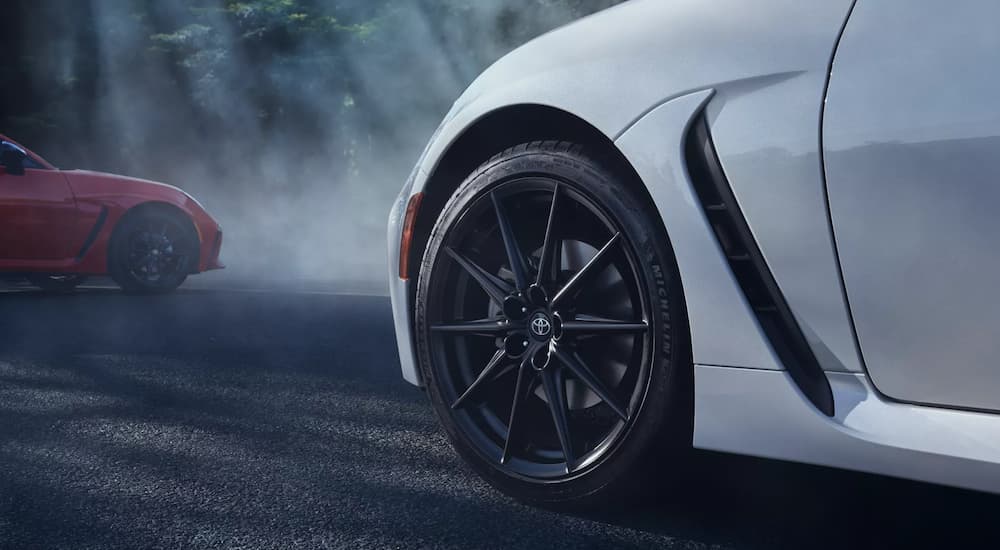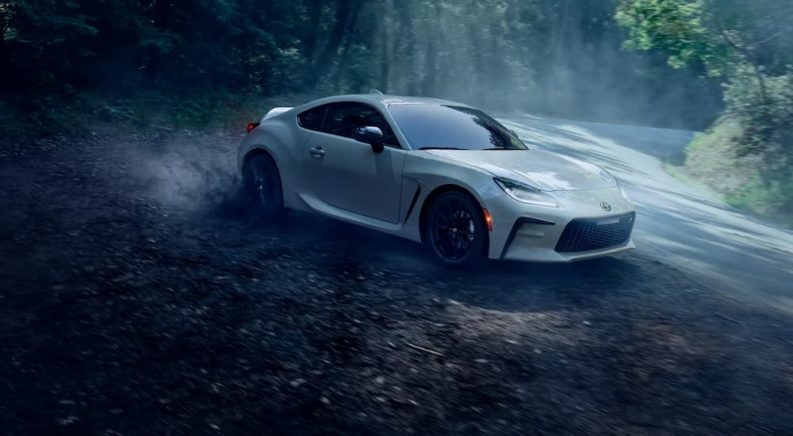The backstory of the Toyota 86 (also known as the “Hachiroku,” which means “86” in Japanese) begins like a trickle-down tidal wave that became a tsunami of possibilities for throngs of young Japanese auto enthusiasts and performance-hungry drivers. The impact was so infectious, a new culture, industry, and genre were established after the release of the now emblematic, game-changing Toyota AE86. As the new GR86 rolls out to Toyota 86 dealerships, let’s delve into the 86 foundation, the evolution of an unprecedented auto-related genre, and meet the influencers and players associated with the movement.3
A Storm on the Horizon
Once the AE86 became a reality, the sleek, optimally stanced, high-revving, and affordably customizable car was about to throw the Japanese car culture for a loop… literally. Drifting had become a phenomenon, and the sweetly responsive steering and handling of the AE86 — with a rather ingenious distribution of its ‘feathery’ 2381 lbs curb weight — was simply the perfect storm for the average tuner-fiend and aspiring drifter. The nimble and highly sensitive AE86 was a natural for the geographical backdrop of hilly and mountainous roads around the Japanese region. As seen in many videos and movies, the winding blacktop provided a par-excellence of drifting opportunities. Although indigenous to Japan, the popular racing style eventually spread across the globe and has been a driving sensation for over a quarter-century since.
Keiichi Tsuchiya: DRIFT KING (and More)
Even though Keiichi Tsuchiya is almost always associated with the byname “Drift King,” it’s actually not solely related to his drifting skills; quite the contrary. Although an accomplished drifter, Keiichi has trophies in his case from victories at the 24-Hours of Le Mans, the Japanese Touring Car Championship, and other notable motorsports events. The moniker is actually a reference to his propensity for applying drifting techniques in non-drifting racing events.
Keiichi had it in the blood from an early age. He worked multiple jobs to pay for his dream ride: a Toyota AE86. Keiichi then took on the Japanese touge (mountain pass), which was instrumental in the genesis of what became drifting. He developed close relationships with Japanese engineers and earned a solid reputation in racing circles. In what may be Keiichi’s most memorable comment, he was quoted as saying, “I drift not because it is a quicker way around a corner, but the most exciting way.” Quite fitting, Keiichi was a consultant for the third installment of the Fast and Furious movie enterprise with the 2006 release of Tokyo Drift.

Strike While the Iron is Hot: The Initial D Manga and Anime Empire
If you’re familiar with the AE86 craze, the name Shuichi Shigeno is one you’ve likely heard time and again. Shuichi is a successful manga creator, and just prior to the cult-like explosion of the drifting phenomenon, he was the originator of an award-winning manga series titled “Bari Bari Densetsu” (Vroom Vroom Legend), that followed a young street-racing motorcycle character through his trials and experiences. In case you’re wondering, manga is simply graphic novels, whereas anime utilizes animation.
As the street and mountain-road racing cavalcade overtook the Far-Eastern nation, Shigeno smartly came forward with a manga that focused on the sweeping mania. His “Initial D” became a wildly popular series that had a storyline similar to the Bari manga but was based on the young driver of an AE86. The main character was based on the life of Keiichi Truschiya, who served as a technical director for the series in its early stages. Despite the success of the series, it wasn’t readily accepted by everyone in the traditionalist Japanese culture. The illegal aspect of street racing was viewed as socially unacceptable. Nonetheless, the Initial D manga had a stunning 18-year run from 1995 to 2013. Along the way, the premise of the storyline and, of course, the uber-idolized performance cars (particularly the AE86) were adapted for use in 20 video games and a movie! There was simply no stopping this runaway train.
Mister Hachiroku
The man commissioned as Chief Engineer for the new Toyota FT-86 project, Tetsuya Tada, is affectionately known (among other titles) as Mister Hachiroku. Before becoming a legendary figure in the auto world, Tetsuya Tada was a passionate rock guitarist in high school who aspired to build electric guitars for Yamaha’s music division. Once his father, a rally-car driver and avid performance seeker himself, ceremoniously dropped the keys to a gifted Toyota Publica in his hands, the wheels started in motion toward an entirely new career path.
Tada eventually ended up joining Toyota as a graduate software engineer and initially focused on ABS and traction control applications. His onward journey then had a stop as project leader on Toyota’s Raum line (a smallish, minivan-type vehicle). Although a notable career accomplishment, it didn’t fill the void within Tada, who had a yearning for higher performance:
“At that time, I was in charge of minivans and of course the number of sales were going upwards and upwards, and the prospect of Toyota being ‘Number One’ was coming close. People were saying, ‘wow, Toyota is going really well,’ however, journalists would always say at the end of interviews: ‘Toyota’s cars are easy to use, they don’t break and are good value … but they’re not fun, they’re not interesting,” Tada said.
With an inner visionary fire just waiting to be stoked, he was naturally a bit forlorn:
“As soon as I moved to that planning department, I asked Tsuzuki-san [referring to his influential mentor Isao Tsuzuki], what car am I making? He said I’d be working on the Raum. I was asked to do the plan for that car; I was really disappointed — it wasn’t a sports car!”
To his distress, the company simply wasn’t receptive to any blueprints that didn’t lead to profit:
“At the time, Toyota was trying to get the number-one sales spot in the world, and was walking away from making ‘inefficient’ sports cars that could not give us the number of sales,” says Tada. “We shifted to more [profitable] cars.”
A Dream Materializes
As the years passed, Tada continued to do his chiefly duties in rolling out anything but sports-car types from the factory. Much to his delight, he finally found himself on the cusp of his dream scenario. Toyota, in what must have been a mini-shock to Tada, decided to mull over a new sporty project. Tada recalls “the meeting”:
“You need to remember that this car was the result of an executive board meeting at Toyota in 2007 with the sole agenda that people around the world are losing interest in cars and what Toyota was going to do about it. One suggestion on how to address this was to go back to basics with a sports car that would rekindle interest. In the past, sports cars had been repeatedly rejected as having a poor return on investment, but at this meeting it was decided that if the technology division could make something that could restart interest, then the marketing division would support it.”
Considering his exposure to the AE86 phenomena, Tada was the perfect source to help create a no-nonsense, fun-to-drive sports car that was also relatively affordable. His not-so-enthralling toils on modest, cost-effective, mass-production projects such as the Raum ended up paying major dividends:
“I learned [a lot] from making [mass-produced] small cars. It was really useful, you have to have that kind of accumulated experience, otherwise you won’t be able to make production sports cars.”
The 86 Project is On
Yes, the new 86 project became a striking success, but it wasn’t without some major roadblocks to overcome. In what has now become much more commonplace, Toyota decided to join forces with a competitor – Subaru. By using Subaru’s engine tech and spare production capacity, the feasibility from a cost and production standpoint eventually made sense and got the project a green light.
At the drawing board, Tada was inevitably in a stare-down with longstanding notions of what entailed a great sports car — namely, high speed and horsepower. His foundational influences from the AE86 era clashed with that logic. Tada wanted a sports car that had more than just flashy numbers. In the end, his concept had to be a joy to drive within manufacturing cost guidelines and industry safety and emissions standards. That meant utilizing various components from other Toyota platforms already in use and getting Subaru on board with what was needed on their end.
The idea of a rear-wheel drive, non-turbocharged, direct-injection sports car was still highly scrutinized, and many wondered if it was even possible to build a worthy engine for such a car. Tada found relief in an old friend who lobbied to remove a huge stumbling block:
“Our savior turned out to be the head of engine development Shinzo Kobuki who had also developed the engine for the AE86. He took on the task of persuading the board to allow us to use D4S [fuel-injection technology].”
But convincing the leadership at Toyota to allow another company access to their most advanced fuel-injection technology turned out to be only the first step. Rather than jumping at the chance to learn Toyota’s secrets, Subaru wanted nothing to do with it:
“What’s more Subaru’s reaction was a bolt from the blue. ‘Not over my dead body,’ was their reaction. The rationale was their previous experience with direct injection and the many problems that had occurred. The chief executive officer of engine development had previously been the head of the introduction of direct injection at Subaru and was very anti the idea.”
Considering that did not go well, Tada once again needed a hand from Kobuki to prove to Subaru that the technology was needed:
“So Mr. Kobuki came out for us again. ‘I will convince them,’ he said. In the end, he undertook to take on the warranty for all problems. What really won everyone over was when we built our first engine. You can imagine that the relationship between Toyota and Subaru at the time was very low. Yet out of these feelings and the wall of reluctance, we made a prototype, which had 190 bhp. It started to dissolve the antipathy and marked the start of a mutual respect between Subaru and Toyota engineers.”
And as they say… the rest is history.
The GT-86 Has Arrived
The essence of Tada’s long standing desire for a Toyota sports car can be found in the new-gen project that brought us the latest GR86: a perfectly balanced vehicle that holds true to an old-school, sports-car mix of a naturally aspirated gasoline engine up front, power sent to the rear, and a stick shift in the middle. Still, the project was nearly quashed with the tension Tada experienced in the joint venture involving Toyota and Subaru executives.
There’s plenty of evidence that suggests Tada’s 86 vision surely took some extensive prodding, but it turned out well for those who have indulged in the sensibly attractive features and performance found in the modern 86. All-in-all, the inner workings of the AE86’s inception to its revival with the GT-86 project and its culmination with the 2022 GR86 reveals some interesting details on the monumental impact a singular model of car has had on the automotive and entertainment world.





